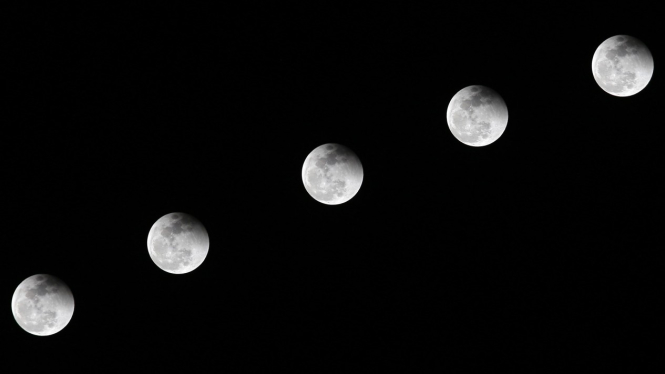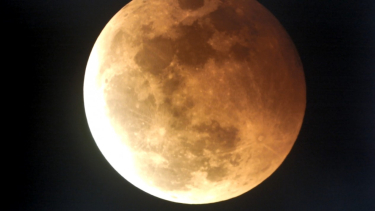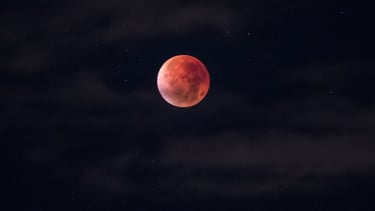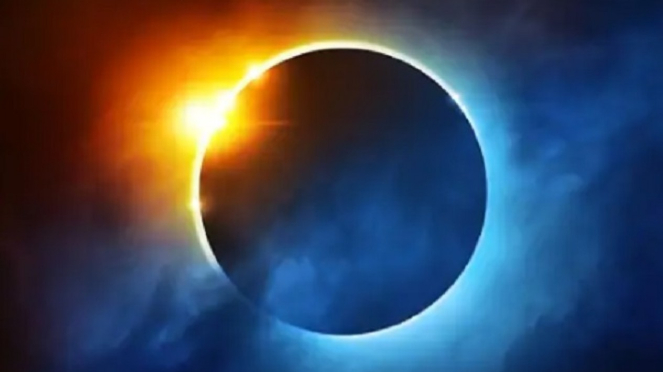Getting to Know Eclipse Types and How They Work
- VIVA/M Ali Wafa
VIVA –Eclipses are one of the most amazing astronomical phenomenon. A total lunar eclipse occurs on November 8, 2022. Last night's phenomenon could be seen in North and Central America, Asia (including Indonesia), and Oceania.
The next total lunar eclipse will only occur in March 2025, according to the United States National Aeronautics and Space Administration (NASA). A lunar eclipse occurs when the Earth is in a straight line between the Sun and the Moon. All of the Sun's light that goes directly to the Moon is blocked by the Earth.
However, the Sun's rays still reach the Moon's surface indirectly, through the Earth's atmosphere. This will make the Moon look like it's bathed in reddish, yellow, or orange light. But this is only one type of eclipse.
"In general, there are two types of eclipses, namely the types Lunar and Solar Eclipses. But technically there is a third type involving two stars," an Astrophysicist from the Center for Science Communication of the Autonomous University, Chile, Juan Carlos Beamín remarked, as quoted from the BBC website, Tuesday, November 8, 2022.
Well, here are the types of eclipses and how they work:
1. Lunar Eclipse
Penampakan gerhana bulan total di Ternate Utara
- tvOne
A lunar eclipse occurs when the Earth comes between the Sun and the Moon. The Earth blocks the Sun's rays. In other words, during a lunar eclipse, what we see is the shadow of the Earth on the surface of the Moon.
During a Total Lunar Eclipse, NASA explains that the Moon and the Sun are exactly in a straight line with the Earth. Although the Moon is in the shadow of the Earth, some of the Sun's rays can still reach the Moon.
The Sun's rays pass through the Earth's atmosphere, which filters out most of the blue light - therefore, during this phenomenon, the Moon looks red and is sometimes referred to as a 'Red Moon.
"Because the Earth's diameter is five times larger than the Moon's, the shadow cast is wider, so the Lunar Eclipse may last more than 104 minutes," according to NASA.
2. Partial Lunar Eclipse
As the name implies, a Partial Lunar Eclipse occurs when only part of the Moon falls into the Earth's shadow. The color of the Moon during an eclipse depends on its distance from the Earth, the closer it is the more liver-red it is, but sometimes it also appears as a copper rust color, or charcoal gray, it may appear in dark areas of the Moon's surface.
This is due to the contrast between the shadowed areas, and the bright areas that are not shadowed or exposed to direct Sunlight. According to NASA, Total Lunar Eclipses are rare phenomena, while Partial Lunar Eclipses occur at least twice a year.
3. Penumbral Lunar Eclipse
This eclipse occurs when the Moon passes through the Earth's penumbral shadow, which is the shadow that falls fainter. Therefore, this type of eclipse is not so obvious, so the perception captured by the human eye depends on the part of the Moon that enters the penumbral region: the smaller it is, the more difficult it is to observe.
For this reason, Penumbral Lunar Eclipses are often not mentioned in public calendars, apart from scientists.
4. Solar Eclipse
Gerhana matahari
Sometimes, when the Moon circles the Earth, it will be positioned between the Sun and our planet. The Moon blocks light from the Sun, which causes a solar eclipse when captured from Earth.
In other words, the Moon casts its shadow on the Earth's surface. However, there are also three types of Solar Eclipses, and these differ from each other depending on how much of the Moon covers the Sun.
5. Total Lunar Eclipse
Ilustrasi Gerhana Bulan Total.
- www.pixabay.com/Free-Photos/9199 images
A total lunar eclipse occurs when the Sun, Earth, and Moon are in alignment. Sunlight entering the Earth is completely blocked by the Moon. For a few seconds (or sometimes up to minutes), the sky becomes dark and looks like nighttime.
"Total solar eclipses are only possible on Earth due to coincidental events related to space. The Sun is 400 times wider than the Moon, but it's also 400 times farther away," NASA said.
"That geometry means that when perfectly aligned, the Moon blocks the entire surface of the Sun, creating a total solar eclipse," NASA added.
The line tracing the Moon's shadow on the Earth's surface is called the "path of totality", and it is in that small area that total darkness will occur.
As for the frequency of occurrence, it's not as rare as you might think: solar eclipses can happen every 18 months. What is truly rare is a Total Solar Eclipse that occurs in the same place. This phenomenon can happen once every 375 years. A Total Solar Eclipse will occur in April 2023.
6. Ring Eclipse
Gerhana Matahari Cincin.
- VIVAnews/Ardian
When the Moon is farther from the Earth and appears 'smaller', it does not completely cover the surface of the Sun. Thus, an outer ring of the Sun appears around the Moon, and this event is referred to as a Ring Solar Eclipse.
Just as during a Total Solar Eclipse, during this phenomenon there is an 'annularity path' where the eclipse is seen as a ring. On each side of this path, in turn, some regions are affected.
In October 2023, the Ring Eclipse will be visible in North and South America. According to NASA, this type of eclipse usually lasts the longest, when the ring appears it can last more than ten minutes, but on average it lasts no more than five or six minutes.
7. Hybrid Eclipse
Beamín explains that a hybrid eclipse is a phenomenon that occurs "when the Moon is at a distance where it can cover the Sun completely, but in its movement, it moves slightly away from the Earth, and stops covering the Sun, then turns into a ring eclipse."
"It can also start as a ring eclipse, and then come a little closer to being a total eclipse," Beamín added.
Hybrid eclipses are quite rare (accounting for only 4% of all solar eclipses), according to the Instituto de Astrofísica de Canarias (IAC). According to Nasa, this hybrid eclipse last occurred in 2013, and we'll have to wait until April 20, 2023, to see it again, when it will be visible in Indonesia, Australia, and Papua New Guinea.
8. Stellar Eclipses
Not all eclipses involve just the Sun and Moon: distant stars can experience eclipses too.
"Because there are so many stars in our galaxy, some of those binary stars [stellar systems consisting of two stars circling the same center of mass] orbit in a very parallel plane to Earth, so at a certain part of their orbit, one star passes in front of the other, obscuring it," Beamin added.
As information, these double stars are called eclipsing binary stars.

































